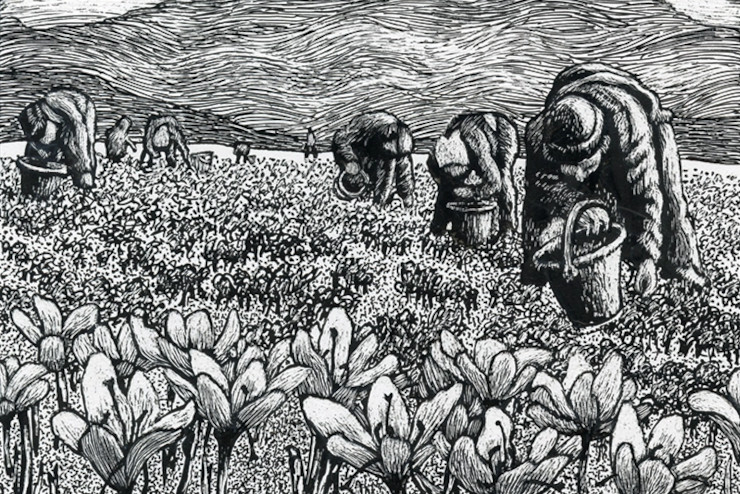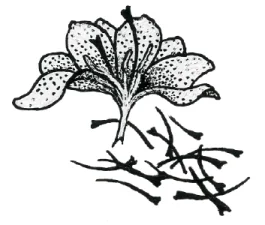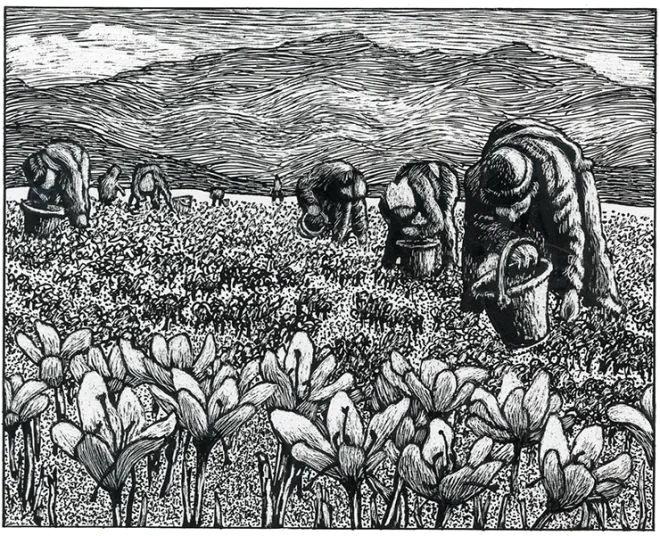
I get it. Garden decor is usually along the lines of gnomes or flags or maybe pinwheels. But garden monkeys? It gets more interesting, though, because I’m not talking about garden monkeys as a decoration. Nope. I mean real, live, actual monkeys.
In truth, I have no idea how much it would cost to hire trained monkeys to help with a harvest. But when that crop is saffron from the Crocus sativus, and they bloom all at once, you need some help. And according to a fresco from over 2,100 years ago, that’s what the people of Crete did. They used trained garden monkeys to help harvest saffron.
Why am I telling you this? Because today’s story from Becky Rupp is all about saffron, crocuses, and trained monkeys. More specifically, The World’s Most Expensive … Crocus is a story about the history and science of one of the culinary world’s most treasured spices.
What makes saffron so special? Saffron, which brings a distinctive color and aroma to dishes such as paella, comes from the stigmas of the autumn crocus. Each flower produces three “threads” of saffron. These threads need to be harvested by hand as soon as the crocuses bloom. And since these flowers bloom all at once, and since you need anywhere from 50,000 to 250,000 flowers to produce one pound of saffron, things can get pretty hectic.
Of course, you can also see why the spice is so expensive. But if you’re willing to bring in some trained garden monkeys, you could grow crocuses and pull in somewhere around $10,000 per pound of saffron.
Get Your Science and Garden Monkeys All In One Place
This story comes from our archive that spans over 30 years and includes more than 130 magazine issues of GreenPrints. I love pieces like these that turn stories inspired by nature into prescient life lessons. I hope you do, as well. Enjoy reading!

The World’s Most Expensive … Crocus
Grow rich (or not).
By Becky Rupp

The next potential big crop for Vermont, says the front page of our local newspaper, is saffron. The saffron story shared the headlines with the school lunch program, the Little League scores, and a debate over a new fire engine purchase, which shows the sort of comforting, low-level news we get up here just south of the Canadian border. For the real scoop, we read The New York Times, which is more informative, but a lot more depressing. I mean, catch The New York Times putting crocuses, Pizza Day, and the Little League on the front page.
We grow crocuses, but ours are spring bloomers, not the potentially big-crop kind. Saffron comes from the stigmas of Crocus sativus, the autumn or saffron crocus. Each of its purple flowers produces just three skinny stigmas, which means that if you’re the impatient type, you should go for something splashier, like radishes or zucchini. Saffron is small. The stigmas are known as “threads,” which they’re literally the size of, which brings us to the downside(s) of being a saffron grower.
First, the flowers bloom all at once—and last only a day before beginning to wilt and wither. Second, the threads must be harvested immediately and by hand. Third, since crocuses grow low to the ground, harvesting, willy-nilly, involves a lot of back-crippling bending over. And fourth, it takes at least 50,000 to 75,000—some sources say as many as 250,000—crocuses to produce a pound of threads. (An acre of crocuses—which may contain, at best guess, a gazillion crocuses—is supposedly good for about 10 pounds of saffron threads.)
Reading that, I can’t help thinking Vermont might be better off sticking to maple syrup and cows.
The end result of all this is an income of $500 to $5000 per pound (wholesale), depending on the quality of your saffron. Saffron isn’t sold by the pound, however—it’s sold by the gram, like drugs. It comes in tiny little vials and you use tiny little bits of it to make paella and saffron rice. We have a gram of it in a drawer in the kitchen. It cost, as I recall, $25 (retail), and I’m afraid to use it.

However, people have been using—and presumably paying through the nose for—saffron for millennia. It was grown by the Minoans on the island of Crete around 1500 BCE; a palace fresco of the time shows what appear to be trained monkeys harvesting saffron threads, which proves that the Cretans didn’t like bending over either.
The ancient Greeks grew it. The original Crocus, according to Greek mythology, was a son of Europa, in love with, but spurned by, the wood nymph Smilax. When the desperate Crocus unwisely asked the gods to do something to make Smilax love him back, they turned him into a flower, which almost certainly isn’t what he had in mind.
An alternative story claims that Crocus was a pal of the god Hermes, who accidentally killed him in a game of discus. Hermes then—inadequately in my opinion—patched things up by turning him into a flower. A similar fate befell Hyacinthus, who got creamed with a discus while playing with Apollo and then turned into a hyacinth; and then there’s Narcissus, a youth so gorgeous that he became entranced with his own reflection, and stared at it obsessively until he dropped dead. Collectively, Greek myths are enough to put you off bulbs.
Strictly speaking, however, crocuses are not bulbs, no matter what our local co-op annually insists. Crocuses, like gladioli, are propagated via corms—which are bulblike, but not bulbs, though frankly only a botanist could tell the difference. Corms are flatter than bulbs, and don’t have the layered scales that you find in true bulbs, like those of onions and tulips. And when it comes to crocuses, we need those corms. The saffron crocus is triploid—that is, it has three sets of chromosomes—which means that it’s such a genetic mess that it’s infertile and unable to produce seeds. For the crocus, corms are it, and if they’re not periodically dug up and transplanted by us, the crocus is kaput.
Saffron crocus corms came to the American colonies in the 18th century—packed in a trunk—with German and Swiss settlers who ended up in Pennsylvania. It was a good use of trunk space; by 1730, the listed price of saffron on the Philadelphia commodities exchange was equal to that of gold. Today it’s slipped a bit: At an average of $11 per gram, saffron beats truffles ($5/g), but lags behind caviar ($35/g), gold ($39/g), and rhino horn ($55/g). A gram—just to keep things in perspective—is about the weight of a paperclip. Saffron is pricey.
Which brings us to the criminal side of the crocus. Let’s just imagine you’ve made a lousy investment in transatlantic galleons and you’ve got five daughters who need dowries. Who wouldn’t be tempted?
Anything as expensive and in demand as saffron inevitably is a hot target for fakery and adulteration, a problem that has been endemic for at least 600 years. Over the centuries, canny crooks have foisted safflower, turmeric, and marigold petals on the public in lieu of saffron, with varied degrees of success. Nowadays, if you get caught doing this, you get fined. In medieval Europe, you got executed.

If in doubt, modern saffron purchasers today turn to chemistry. Saffron contains close to 200 different compounds that contribute to its distinctive color and aroma. Its bright-yellow color is due to a carotenoid called alpha-crocin; its aroma—described by many as smelling like hay—is due to a volatile oil called safranal. In other words, if you’re thinking of cheating, don’t. There are people out there with spectrophotometers.
Unlike the spring crocus, which we plant in the fall in hopes that it will manage to struggle up through the snow drifts in the spring, the saffron crocus is planted right now, in the summer, and will bloom—very briefly—in October.
At the very least, they’ll look gorgeous.
But I’d think twice about the saffron business. Unless you’ve got a lot of trained monkeys. ❖
By Becky Rupp, published originally in 2017, in GreenPrints Issue #110. Illustrated by P. Savage

Have you ever grown crocuses to collect saffron? What was the experience like?




I planted some (I don’t remember how many, but surely less than 50 – probably much less) at least ten years ago. A few still survive – barely, I think, but I’ve never seen a single flower. sigh